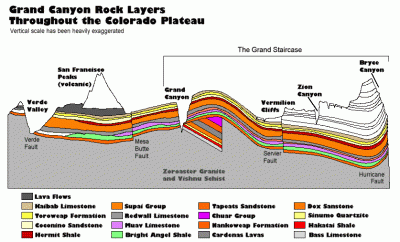Madeline Kollegger and Taylore Grunert
The Grand Canyon is known around the world for its incredible layers, and defying depth. It formed from the bed of the Ancient Colorado River, as it wound around the plateaus in the Colorado Plateau Province. The water in the river, and the sediment it carried wore away at the bed for ages, until the canyon was formed. The very bottom layer of the Grand Canyon is made from sediment and lava deposits that were later uplifted into mountains. (United States)

Figure 1: Grand Canyon Rock Layers Throughout the Colorado Plateau.
While made of many layers, from a variety of different times, and events, most of the rock that makes up the Grand Canyon is sedimentary. The sediments that form the rocks were deposited by the advance and retreat of ancient ocean shorelines due to changes in climate. As the earth was colder, there was more ice, and the coastlines were farther out, and as it was warmer the lack of ice caused the sea levels to rise.
The top layer of the Grand Canyon is the Kaibab Limestone, ages about 250 million years old. It contains the fossilized remains of a variety of ocean creatures such as mollusks and coral. Looking at other formations in the Colorado Plateau (see Figure 1), we know that younger layers have been eroded from the Grand Canyon. Bryce Canyon, farther north from the Grand Canyon has layers that are dated as much younger.
The oldest layer of the Grand Canyon is known as the Bass Formation, dated 1.25 billion years ago. This layer contains algae (Stromatolites) that reaffirm that the area was ocean at the time the sediment was deposited. However, the base of an ancient mountain range is the very bottom of the canyon, formed about 1.7 billion years ago. Between that ancient mountain range, and the Bass Formation, there is a rock unconformity that indicates changes and missing rock from the record. There is another unconformity between the layers known as the Chuar Group, and Tapeats Sandstone. Dated at 250 million years ago, the unconformity also indicated a change in the rock record, missing layers. (Geology)
Today, the Grand Canyon is protected as part of the National Parks system. However, it still faces multiple threats from human activity. For example, the Grand Canyon ecosystem has been greatly altered by the controversial Glen Canyon Dam (Loomis). Certainly, the sediment and water accumulation caused by the dam has changed how this system functions in the Grand Canyon.
Additionally, this protection has historically been threatened by mining interests, and continues to be. Uranium mining not only contributes to the destruction of geological features in the canyon, but also pollutes rivers and creates toxic conditions for all living things, including people (Grand Canyon Trust).
Furthermore, the Colorado River itself is extremely overused and mismanaged. This isn’t necessarily bad for the canyon itself, as decreased input into the system by water would mean decreased erosion. However, this is still, on the whole, negative: it adversely affects ecosystems, people, and the economy (Davis).
Works Cited
“Administrative History of Grand Canyon National Park”, 2000, National Park Service. Retrieved Jan. 24, 2017 from https://www.nps.gov/grca/learn/historyculture/adhigrca.htm
Davis, Shoshana. “Colorado River Named Nation’s Most Endangered Waterway”, CBS News, April 22, 2013. Retrieved Jan. 24, 2017 from http://www.cbsnews.com/news/colorado-river-named-nations-most-endangered-waterway/
The Geology of the Grand Canyon. (n.d.). Retrieved January 24, 2017, from http://www.bobspixels.com/kaibab.org/geology/gc_geol.htm
“Grand Canyon Uranium Mining” Grand Canyon Trust, n.d. Retrieved Jan. 24, 2017 from http://www.grandcanyontrust.org/uranium-mining
United States. National Park Service. (n.d.). Geologic Formations. Retrieved January 24, 2017, from https://www.nps.gov/grca/learn/nature/geologicformations.htm
Loomis, Brandon. “50 Years Later, Glen Canyon Dam Still Controversial”, USA Today, Oct. 14, 2013. Retrieved Jan. 24, 2017 from http://www.usatoday.com/story/news/nation/2013/10/14/glen-canyon-dam-50-years/2981273/